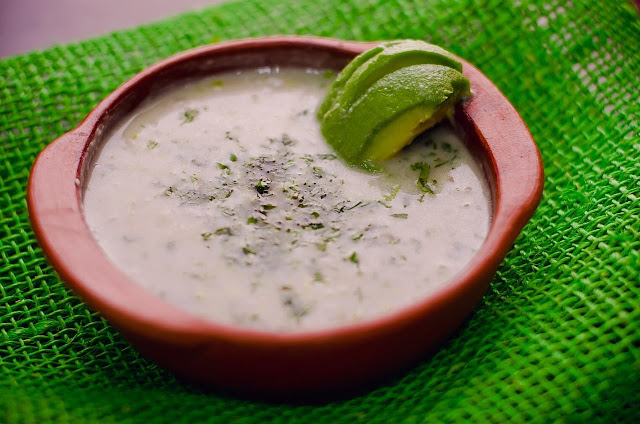Loja's Repe Soup - Green banana comfort food
 |
| A bowl of the best: repe soup served by Café Indera |
Short read: All regional comfort foods have in common their prosaic ingredients and fierce devotion from the people who were raised eating them. Understanding the nuances of a local dish, part of the identity of an entire city, is its own right of passage. Loja in southern Ecuador, the last major city before you reach Peru, is no different. Repe soup - sopa de repe, or green banana soup - is the comfort food Lojanos are known for. Along with other famous dishes on offer in the charming small city, such as roast pork, Lojano coffee, cuy (guinea pig), and empanadas, one has not truly experienced Loja without sampling Repe.
When ordering Repe Lojano, you will be presented with a warm creamy soup made with green unripened bananas, onions, garlic, milk, farmer cheese and cilantro, garnished with avocado slices, more fresh cilantro, and possibly crumbled cheese. Most full-service restaurants and small cafes in Loja offer Repe or may bring it to you as part of their luncheon (almuerzo) set menu soup course. Our favorite rendition of the soup is at one of the ultimate insider food spots in Loja, Café Indera on 18 de Noviembre Street, one half block north of the city’s main indoor produce market, Mercado Centro Comercial. Indera is also a great place to order equally famous Lojano filtered coffee (café filtrado), and take a pound of beans away with you for the next morning.
 |
| Green bananas |
Soup, after all, is one of the oldest dishes known to humanity. Archaeological evidence places soup making as far back as about 20,000 BC. Boiling was not an important cooking method until humankind produced its first waterproof containers, most likely clay pots of some kind. Animal hides and watertight baskets of bark or reeds were also used. Boiling was necessary to make tough food chewable. The resulting cooking liquid was also good tasting, and soup was born. According to Ecuadorian chef Edgar León, who literally wrote the book on the subject, “Soups, the identity of Ecuador,” says that soup is about community because it is always made for more than one person. Gonzalo Berneo, a Lojano from one of the province’s oldest families, amplifies this idea when he remembers an antique cookbook from his family’s hacienda that described a recipe for Repe calling for massive quantities of ingredients, such as liters of water and entire wheels of cheese.
Chef León goes on to say that only the giant territory of China has more varieties of soup than Ecuador. León documented over 750 recipes for soup currently being cooked and served up in diminutive Ecuador. León says that in the Andean sierras Locro, or potato soup, is king. León classifies Repe soup as a variety of Locro. One might quibble with that label, but many recipes for Repe do include potatoes. The star ingredient of Repe, green bananas or guineos verdes, could have been introduced into Sierran Locro soups sometime after bananas and plantains made their arrival in Ecuador with the Spanish, having first spread to India and Africa from Southeast Asia. Green bananas and their cousins, the plantain, eventually became important food staples in all the warmer coastal countries of Latin America.
There are many ways of parsing the lineages of bananas and plantains. Sciencey-types want to talk about strains of DNA shared, or not, between the different varieties. However, most North Americans and Europeans will most readily recognize the so-called sweet “dessert banana,” which is usually eaten raw, typically of the unblemished kid’s-raincoat-yellow Cavendish variety. “Cooking bananas,” on the other hand, include the larger and lankier plantain, with its firm starchy interior and tough leather outer skin which most often must be cut off. The classification confusion is bound to continue because if the truth be told, both plantains and bananas can be cooked when green, and eaten raw when ripe.
One of our city’s most well-known chefs, Luis Alvear Ramos, owner-manager of the 'Rincon de Burgundy restaurant at Loja’s landmark City Gate, believes that the history of Repe is more recent. He thinks the green bananas were brought from the coastal growing areas during times of drought and political troubles with Peru. To solve the food shortages of the time, the people of Loja made the green guineo bananas, originally used as animal feed, into a delicious and satisfying soup. This backstory may have much to do with Repe’s reputation as a “poor people’s dish.” Alvear agrees with Chef León that some do add potatoes to their Repe pot, but purists just use the green bananas. Alvear also cautions that one should not confuse Repe with another popular local soup, which has dried peas with green bananas, the popular “Arvejas con guineo.”
 |
| Screen shot for Laylita's version of repe soup |


Comments
Post a Comment